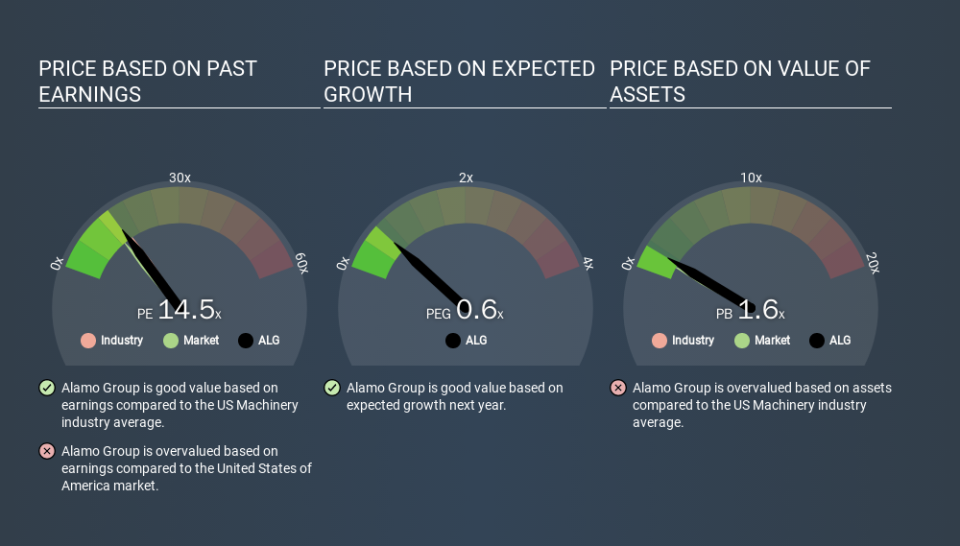What Is Alamo Group's (NYSE:ALG) P/E Ratio After Its Share Price Tanked?

To the annoyance of some shareholders, Alamo Group (NYSE:ALG) shares are down a considerable 40% in the last month. The recent drop has obliterated the annual return, with the share price now down 22% over that longer period.
Assuming nothing else has changed, a lower share price makes a stock more attractive to potential buyers. In the long term, share prices tend to follow earnings per share, but in the short term prices bounce around in response to short term factors (which are not always obvious). So, on certain occasions, long term focussed investors try to take advantage of pessimistic expectations to buy shares at a better price. Perhaps the simplest way to get a read on investors' expectations of a business is to look at its Price to Earnings Ratio (PE Ratio). Investors have optimistic expectations of companies with higher P/E ratios, compared to companies with lower P/E ratios.
View our latest analysis for Alamo Group
How Does Alamo Group's P/E Ratio Compare To Its Peers?
Alamo Group's P/E is 14.50. As you can see below Alamo Group has a P/E ratio that is fairly close for the average for the machinery industry, which is 13.7.
Alamo Group's P/E tells us that market participants think its prospects are roughly in line with its industry. So if Alamo Group actually outperforms its peers going forward, that should be a positive for the share price. I would further inform my view by checking insider buying and selling., among other things.
How Growth Rates Impact P/E Ratios
Generally speaking the rate of earnings growth has a profound impact on a company's P/E multiple. If earnings are growing quickly, then the 'E' in the equation will increase faster than it would otherwise. That means unless the share price increases, the P/E will reduce in a few years. Then, a lower P/E should attract more buyers, pushing the share price up.
Alamo Group's earnings per share fell by 15% in the last twelve months. But it has grown its earnings per share by 9.1% per year over the last five years.
A Limitation: P/E Ratios Ignore Debt and Cash In The Bank
It's important to note that the P/E ratio considers the market capitalization, not the enterprise value. That means it doesn't take debt or cash into account. In theory, a company can lower its future P/E ratio by using cash or debt to invest in growth.
Spending on growth might be good or bad a few years later, but the point is that the P/E ratio does not account for the option (or lack thereof).
Alamo Group's Balance Sheet
Alamo Group's net debt equates to 44% of its market capitalization. While that's enough to warrant consideration, it doesn't really concern us.
The Bottom Line On Alamo Group's P/E Ratio
Alamo Group has a P/E of 14.5. That's higher than the average in its market, which is 11.8. With some debt but no EPS growth last year, the market has high expectations of future profits. What can be absolutely certain is that the market has become significantly less optimistic about Alamo Group over the last month, with the P/E ratio falling from 24.2 back then to 14.5 today. For those who prefer to invest with the flow of momentum, that might be a bad sign, but for a contrarian, it may signal opportunity.
Investors have an opportunity when market expectations about a stock are wrong. If the reality for a company is better than it expects, you can make money by buying and holding for the long term. So this free visualization of the analyst consensus on future earnings could help you make the right decision about whether to buy, sell, or hold.
Of course you might be able to find a better stock than Alamo Group. So you may wish to see this free collection of other companies that have grown earnings strongly.
If you spot an error that warrants correction, please contact the editor at editorial-team@simplywallst.com. This article by Simply Wall St is general in nature. It does not constitute a recommendation to buy or sell any stock, and does not take account of your objectives, or your financial situation. Simply Wall St has no position in the stocks mentioned.
We aim to bring you long-term focused research analysis driven by fundamental data. Note that our analysis may not factor in the latest price-sensitive company announcements or qualitative material. Thank you for reading.

